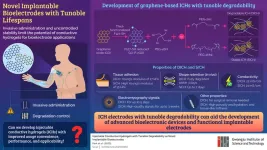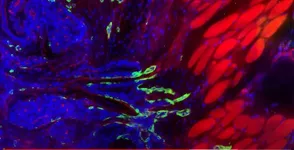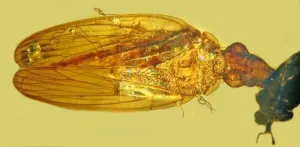(Press-News.org) UW Medicine genome experts made significant scientific contributions to a National Institutes of Health Human Genome Research Institute reference collection that better represents the genetic diversity of the world’s populations.
Called the Human Pangenome Reference Consortium, the multi-institutional effort expands and updates earlier work that started as the Human Genome Project. That original project, with drafts reported in 2001 and 2003, was based on a more limited sampling of human DNA. The goal then was to create an entire sequence of a human genome to use as a reference. It reflected data mostly from one person, with slight amounts of genetic information from about 20 others. That project was officially completed in 2022 with the release of the first telomere-to-telomere human genome.
The human pangenome reference, in contrast, contains nearly full genomic data from 47 people whose ancestry traces to different populations around the globe. This represents 94 human genomes because each person carries two copies, one from each parent.
“The pangenome approach represents a new way of thinking about human genetic variation,” said Evan Eichler, professor of genome sciences at the University of Washington School of Medicine in Seattle and one of the senior scientists in the Human Pangenome Reference Consortium. “It has the potential not only to improve discovery of genetic diseases but also transform our understanding of the genetic diversity of our species.”
The present pangenome draft reference will continue to be expanded to include DNA sequencing and analysis from people from a variety of other ancestral and geographic roots. Eventually a cohort of more than 350 participants will enable researchers to capture the most common genetic variants, including ones that have been missed previously because they map to complex regions.
The latest research from the Human Pangenome Reference Consortium is reported today in a series of papers in Nature and other scientific journals.
By reflecting variation across human populations, the pangenome reference collection is expected to improve equity in human genome research. Individuals and families from a wider range of backgrounds might benefit from new clinical advances based on knowledge of how genetic variation influences human health.
Researchers are already making discoveries that could not have been possible through previous human genome reference sequences.
The pangenome project studies in which University of Washington School of Medicine scientists made significant contributions were:
Drafting the Pangenome Reference
The overall project report, “A draft human pangenome reference,” is published in Nature. Eichler, an expert in human genome evolution and variation, and their relation to disease, was among the senior authors. David Porubsky, Mitchell Vollger, William T. Harvey, Katherine M. Munson, Carl A. Baker, Kendra Hoekzema, Jennifer Kordusky and Alexandra P. Lewis, all from his department, were part of the project team.
This paper examines the diploid assemblies from 47 individuals. Diploid assemblies show a person’s DNA sequence inherited from both parents, while only those from one parent appear in haploid assemblies. The assemblies were assessed to determine the extent of their coverage, accuracy, and reliability. The assemblies were found to be nearly complete (more than 99%) and highly accurate at the structural and base-pair levels. The researchers noted these assemblies outperformed earlier efforts at assembly quality, due to state-of-the-art sequencing technology and analytical innovations.
In addition to ascertaining known variants, the assemblies also captured new variants in structurally complex regions of the genome. These regions were previously inaccessible.
The authors also emphasized that the current pangenome reference is still a draft and that many challenges remain in building and refining this reference.
For example, the scientists plan to push towards a telomere-to-telomere or tip-to-tip sequencing of chromosomes to get a more complete picture of how people differ.
“That will give us a more comprehensive representation of all types of human variation,” they noted. The researchers also would like to broaden subject recruitment because the present samples are insufficient to convey the extent of diversity in the human population.
Despite those and other limitations, the researchers anticipate that optimizing the pangenome reference collection will lead rapidly to a broad number of applications for scientists and clinicians.
Uncovering Variation within Repetitive DNA
One of the related papers, a study led by UW Medicine researchers, is “Increased mutation and gene conversion within human segmental duplications,” also appearing in Nature. The lead author is Mitchell R. Vollger, a postdoctoral fellow in genome sciences who collaborated with his colleagues as a student in the Eichler lab and with other Human Pangenome Reference Consortium scientists.
By overcoming previous obstacles in mapping areas of the genome containing large segments of repeated DNA code, they were able to spot more variants at the single-nucleotide level for many regions for the first time.
This is leading to a greater understanding of how, where, and to what degree mutations occur.
They discovered an elevated density of single-nucleotide variants within segmental duplications, compared to unique regions of the genome. They also found that almost a quarter of this increase was due to genes copying to new locations in a process called “interlocus gene conversion.”
The scientists created a map of hotpots that were prime locations for donating or receiving genetic material. They also observed that, from an evolutionary standpoint, areas of segmental duplication were slightly older than other parts of the genome containing unique sequences of DNA. However, this did not explain the increased density of single-nucleotide variants.
Interestingly, the nucleotide cytosine was more likely to convert to guanine, and vice versa, within duplicated sequences than were conversions among adenine and thymine. (A, T, C and G are the four chemicals that make up the alphabet for the DNA code.)
“These distinct mutational properties help maintain the higher cytosine and guanine content of segmental duplications of DNA, compared to unique DNA,” the researchers reported.
The scientists found more than 1.99 million single-nucleotide variants in these duplicated and gene-rich areas of the human genome—regions previously considered to be unreadable.
“A lot of this new sequence was uncovered last year [as part of the T2T Consortium] in copy number variable regions where there’s lots of differences between people,” Vollger said. “My focus in this latest work was looking at these variable regions and discovering the additional diversity that exists there and beginning to characterize it.”
He added, “Depending on how you choose to count, most human variation comes from these copy number variable regions that are only going to be unlocked using a pangenome reference. I think it’s absolutely critical that we continue to push the pangenome resource so that the scientific and clinical research community begins to adopt it.”
Closing the Gaps in Human Genome Assemblies
Another paper that is part of the series from the Human Pangenome Research Consortium appears in the journal Genome Research, under the title “Gaps and complex structurally variant loci in phased genome assemblies.” The lead author is David Porubsky, an acting instructor in genome sciences who conducts studies in the Eichler lab.
“Finishing multiple genomes is more difficult,” Porubsky said, “because human genomes are diploid. People carry two copies of a genome: the one inherited from the mom, and one inherited from the dad. So, the task is harder. That’s why there are gaps remaining. To resolve them, it will require more development in sequencing technology and more development in the underlying assembly algorithms, which we are using to put all these pieces together.”
Traditionally it has been challenging for scientists to separately reconstruct the DNA sequences for the two copies of our 23 chromosomes, but noteworthy progress has been made.
To do so, sequencing data usually is obtained from both parents, as well as from the child. However, in clinical settings, parental data is not always available.
Porubsky, Eichler, and their team are studying an approach that attempts to produce a complete genome assembly showing the set of genes from each parent—but without obtaining any parental data. They use a method called single-cell strand sequencing, or Strand-seq.
Either approach (trio-based or no parental data) can still result in gaps of missing information. The team analyzed gaps, assembly breaks, and misorientations from 77 phased and assembled human genomes from the Human Pangenome Reference Consortium. (A phased genome assembly tries to resolve the groups of variants in the chromosomes passed from each parent.)
The team learned several reasons for gaps arising in both methods, including areas where portions of DNA are incorrectly oriented. Many of these faulty orientations relate to large inversions, where things are figuratively turned upside down or inside out. Most of these occur between identical repeats of DNA code. There were also major assembly alignment discontinuities identified as regions of DNA that had undergone frequent expansions and contractions. Importantly, many of these areas overlapped with protein-coding genes, including areas with variations in copy number (how many times a section is repeated in one individual compared to another).
“My main task in this effort,” Porubsky said, “was to better understand where we are coming short in the genome assembly, where the remaining gaps are, and how to close them. I was looking into where these gaps reside, their frequency, and the sequence properties. We found that many of these gaps are represented by these very long, highly repetitive sequences, which are difficult to assemble under the current technologies and algorithms.”
“We are actually better positioned in the future to resolve them,” he said, “and actually fill in these missing pieces of the puzzle and be able to better understand the human genome—even in these very complex parts of the human genome.”
These regions contain biomedically relevant information, he noted.
“This is very important,” he said, “because many of these complex parts of the genomes are associated with genetic disorders, such as certain forms of autism and Prader-Willi syndrome. Analyzing these regions may help in the future to better understand how to treat and diagnose these genetic disorders and identify perhaps new disorders which haven't been identified.”
“A pangenomic representation [of these regions] would be most useful, yet more challenging, to realize,” the researchers noted in their paper.
The Human Pangenome Reference Consortium work at UW Medicine was supported in part by grants from the U.S. National Institutes of Health (5RO1HG002385, 5U01HG010971, R01HG010169, U24HG007497, and 1UO1HGO01973). Eichler is an investigator of the Howard Hughes Medical Institute.
END
UW Medicine scientists among leads of NIH pangenome studies
University of Washington School of Medicine researchers played key roles on several aspects of a new genomic reference collection representing greater human population diversity.
2023-05-10
ELSE PRESS RELEASES FROM THIS DATE:
The clearest snapshot of human genomic diversity ever taken
2023-05-10
For more than 20 years, scientists have relied on the human reference genome, a consensus genetic sequence, as a standard against which to compare other genetic data. Used in countless studies, the reference genome has made it possible to identify genes implicated in specific diseases and trace the evolution of human traits, among other things.
But it has always been a flawed tool. One of its biggest problems is that about 70 percent of its data came from a single man of predominantly African-European background whose DNA was sequenced during ...
Researchers measure the light emitted by a sub-Neptune planet’s atmosphere for the first time
2023-05-10
For more than a decade, astronomers have been trying to get a closer look at GJ 1214b, an exoplanet 40 light-years away from Earth. Their biggest obstacle is a thick layer of haze that blankets the planet, shielding it from the probing eyes of space telescopes and stymying efforts to study its atmosphere.
NASA’s new James Webb Space Telescope (JWST) solved that issue. The telescope’s infrared technology allows it to see planetary objects and features that were previously obscured ...
Paper refutes assertion that effects of bottom trawling on blue carbon can be compared to that of global air travel
2023-05-10
A ‘Matter Arising’ paper published in Nature today refutes the findings of a paper by Sala et al on the amount of CO2 released from the seabed by bottom trawling. The paper made significant headlines around the world on release in 2021, as it equated the carbon released by bottom trawling to be of a similar magnitude to the CO2 created by the global airline industry.
In their paper quantifying the carbon benefits of ending bottom trawling, Prof Jan Hiddink of Bangor University’s world-renowned School of Ocean Science and others, explain that the methodology ...
Gwangju Institute of Science and Technology researchers develop injectable bioelectrodes with tunable lifetimes
2023-05-10
Implantable bioelectrodes are electronic devices that can monitor or stimulate biological activity by transmitting signals to and from living biological systems. Such devices can be fabricated using various materials and techniques. But, because of their intimate contact and interactions with living tissues, selection of the right material for performance and biocompatibility is crucial. In recent times, conductible hydrogels have attracted great attention as bioelectrode materials owing to their flexibility, compatibility, and excellent interaction ability. However, the absence ...
Study of cancer metastasis, most common cause of cancer death, gets $35 million boost at Johns Hopkins Medicine
2023-05-10
FOR IMMMEDIATE RELEASE
With a $35 million gift from researcher, philanthropist and race car driver Theodore Giovanis, scientists at Johns Hopkins Medicine will study the biological roots of the most fatal aspect of cancer: how it metastasizes, or spreads, through the body.
The contribution, a 15-year commitment, will establish the Giovanis Institute for Translational Cell Biology, dedicated to studying metastasis. The institute’s researchers aim to make discoveries that reveal common features of metastasis across cancer types, ...
Pandemic stress reshapes the placentas of expectant moms
2023-05-10
WASHINGTON (May 10, 2023) – Elevated maternal stress during the COVID-19 pandemic changed the structure, texture and other qualities of the placenta in pregnant mothers – a critical connection between mothers and their unborn babies – according to new research from the Developing Brain Institute at Children’s National Hospital.
Published in Scientific Reports, the findings spotlight the underappreciated link between the mental health of pregnant mothers and the health of the placenta – a critical organ ...
Local Phoenix medical students invited to upcoming medical conference to learn about opportunities in interventional cardiology
2023-05-10
A newly piloted program from the Society for Cardiovascular Angiography & Interventions (SCAI), the leading society representing interventional cardiology, hopes to increase access and encourage interest in interventional cardiology early in students' medical careers.
SCAI's Ready to Launch - Careers in Cardiology program is designed to introduce future physicians to the field of interventional cardiology through a half-day program where attendees will get the opportunity to have impactful conversations with nationally recognized interventional cardiologists, learning about training paths, barriers to care and solutions for the future, the importance of health ...
A jumping conclusion: Fossil insect ID’d as new genus, species of prodigious leaper, the froghopper
2023-05-10
CORVALLIS, Ore. – A fossil arthropod entombed in 100-million-year-old Burmese amber has been identified as a new genus and species of froghopper, known today as an insect with prodigious leaping ability in adulthood following a nymphal stage spent covered in a frothy fluid.
Oregon State University researcher George Poinar Jr., an international expert in using plant and animal life forms preserved in amber to learn about the biology and ecology of the distant past, and his co-author, Alex E. Brown, published ...
Allison Institute announces appointment of inaugural members
2023-05-10
HOUSTON ― The James P. Allison Institute at The University of Texas MD Anderson Cancer Center today announced the appointment of its first members, James P. Allison, Ph.D., Padmanee Sharma, M.D., Ph.D., Jennifer Wargo, M.D., Sangeeta Goswami, M.D., Ph.D., and Kenneth Hu, Ph.D. In addition, Garry Nolan, Ph.D., will join the Allison Institute as an adjunct member.
These members include pioneering researchers who have made notable contributions to science as well as rising stars on the path toward important breakthroughs. This group ...
St. Jude scientist M. Madan Babu elected to the Royal Society of London
2023-05-10
St. Jude Children’s Research Hospital scientist Madan Babu Mohan, Ph.D., Center of Excellence in Data-Driven Discovery director and member of the Department of Structural Biology, has been elected a Fellow of the Royal Society of London. The Royal Society is the oldest scientific academy in continuous existence.
Babu was selected to join the Royal Society for his pioneering data science-based strategies to reveal fundamental principles in biological systems. His scientific accomplishments include determining the molecular mechanisms governing G-protein-coupled receptor (GPCR) signaling, uncovering the roles of disordered protein regions in biology and disease, ...
LAST 30 PRESS RELEASES:
There are new antivirals being tested for herpesviruses. Scientists now know how they work
CDI scientist, colleagues author review of global burden of fungus Candida auris
How does stroke influence speech comprehension?
B cells transiently unlock their plasticity, risking lymphoma development
Advanced AI dodel predicts spoken language outcomes in deaf children after cochlear implants
Multimodal imaging-based cerebral blood flow prediction model development in simulated microgravity
Accelerated streaming subgraph matching framework is faster, more robust, and scalable
Gestational diabetes rose every year in the US since 2016
OHSU researchers find breast cancer drug boosts leukemia treatment
Fear and medical misinformation regarding risk of progression or recurrence among patients with breast cancer
Glucagonlike peptide-1 receptor agonists and asthma risk in adolescents with obesity
Reviving dormant immunity: Millimeter waves reprogram the immunosuppressive microenvironment to potentiate immunotherapy without obvious side effects
Safety decision-making for autonomous vehicles integrating passenger physiological states by fNIRS
Fires could emit more air pollution than previously estimated
A new way to map how cells choose their fate
Numbers in our sights affect how we perceive space
SIMJ announces global collaborative book project in commemoration of its 75th anniversary
Air pollution exposure and birth weight
Obstructive sleep apnea risk and mental health conditions among older adults
How talking slows eye movements behind the wheel
The Ceramic Society of Japan’s Oxoate Ceramics Research Association launches new international book project
Heart-brain connection: international study reveals the role of the vagus nerve in keeping the heart young
Researchers identify Rb1 as a predictive biomarker for a new therapeutic strategy in some breast cancers
Survey reveals ethical gaps slowing AI adoption in pediatric surgery
Stimulant ADHD medications work differently than thought
AI overestimates how smart people are, according to HSE economists
HSE researchers create genome-wide map of quadruplexes
Scientists boost cell "powerhouses" to burn more calories
Automatic label checking: The missing step in making reliable medical AI
Low daily alcohol intake linked to 50% heightened mouth cancer risk in India
[Press-News.org] UW Medicine scientists among leads of NIH pangenome studiesUniversity of Washington School of Medicine researchers played key roles on several aspects of a new genomic reference collection representing greater human population diversity.






